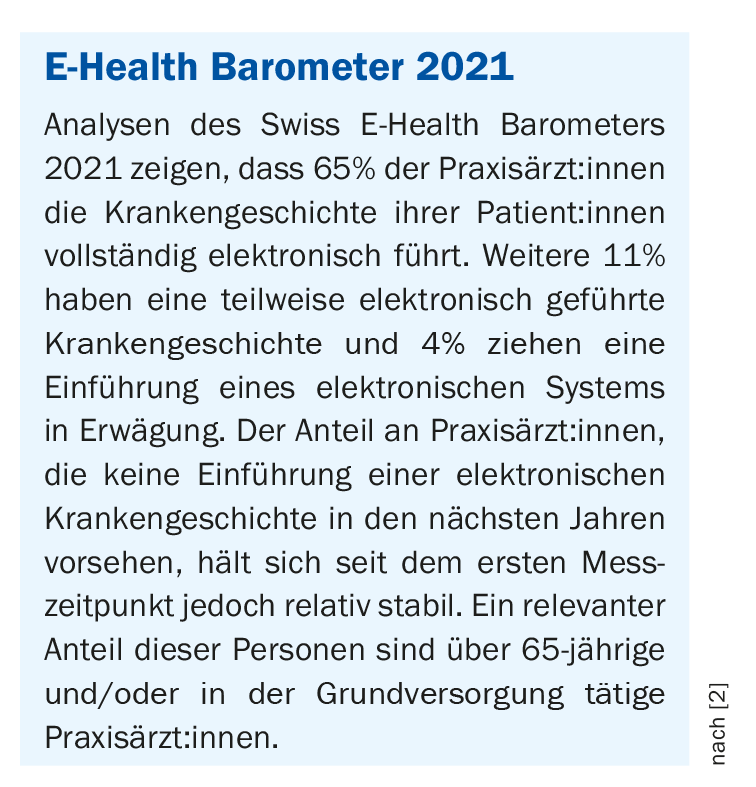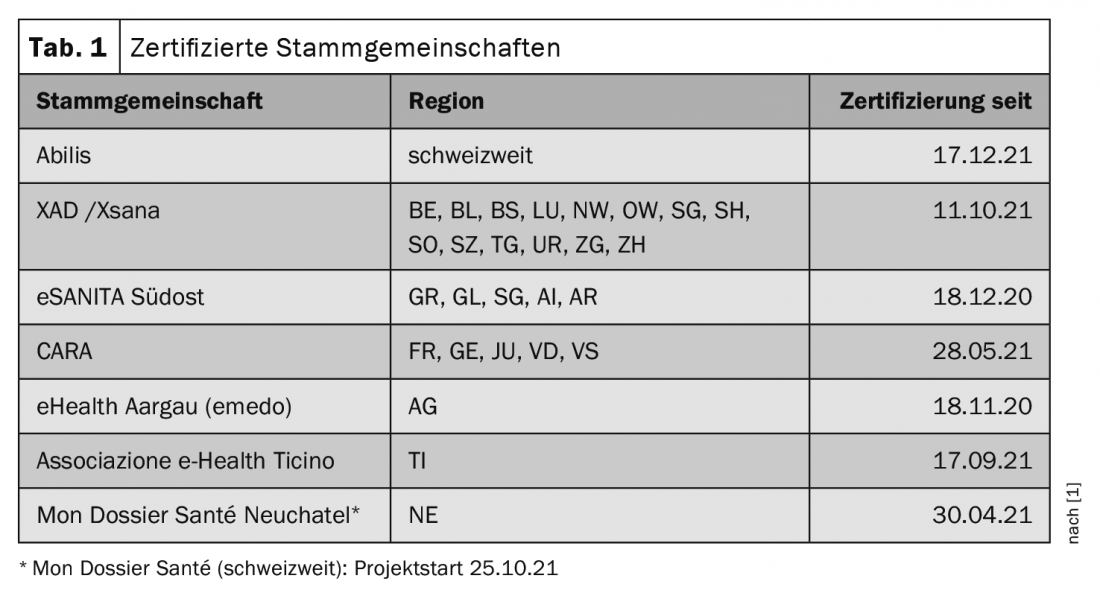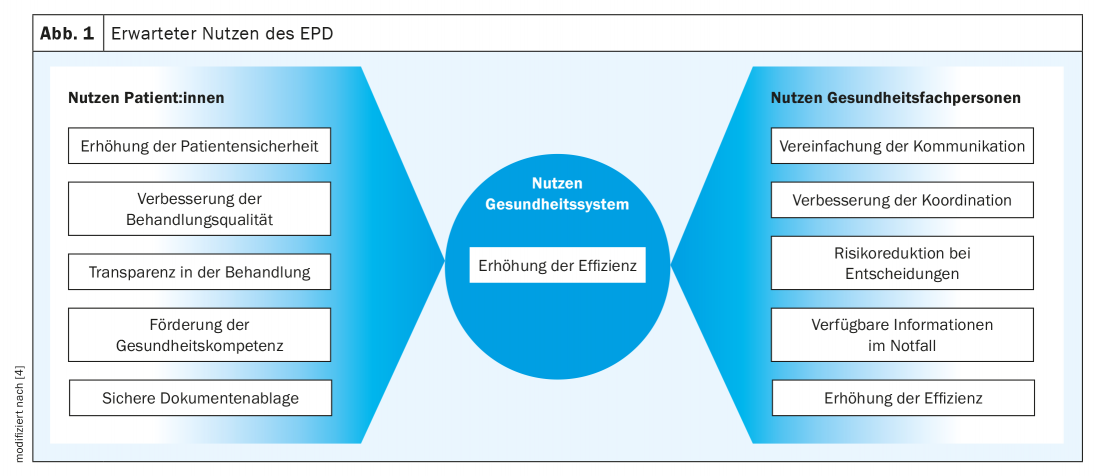The use of electronic patient dossiers (EPD) for the general population has been gradually opened up since the second quarter of 2021. The availability of sensitive medical information is regulated by a decentralized filing system. The data protection and data security requirements of the nationally networked EPD are high. Several regional tribal communities have already been certified and various processes are currently underway.
The implementation of the electronic patient dossier (EPD) is organized in a decentralized manner in Switzerland. Associations of regional implementations are called “communities” or “stem communities”, which are officially certified according to the same rules throughout Switzerland. Currently, the certified home communities are in the process of incorporating and integrating the hospitals, homes and newly licensed physician practices that are required to join. In parallel, the internal processes as well as the technical platform are optimized and the national data exchange with the other certified parent communities is prepared [1]. The nationwide introduction of the EPD in Switzerland is a federally supported project of digitization in healthcare [2]. Since May 2021, several tribal communities have been granted certification [1]. The federal EPD law has been in effect since April 2017, which would require acute hospitals, rehabilitation clinics, and inpatient psychiatric units to be the first to be connected to a (master) community since April 2020 [2]. Certification procedures in this country are carried out by a company recognized by the Swiss Accreditation Service SAS for the certification of EPD (master) communities and EPD identification means. Certification of (tribal) communities must be done carefully to protect patients and therefore takes time [1].

Once a parent community is certified, it can begin rolling out the EPD to its affiliated healthcare professionals and institutions, as well as the population in the catchment area. In doing so, a master community can immediately go into an area-wide regular operation, or it can test and optimize the processes step by step [1]. Progress and implementation are regularly reviewed in Switzerland by the federal and cantonal EPD program committee. All inpatient healthcare facilities as well as newly licensed medical practices are to be connected quickly and the EPD is to be promoted to the population with low-threshold opening options. (Home) communities and their site cantons are encouraged to work to connect other outpatient health care facilities such as doctors’ offices, pharmacies or Spitex services from the outset. It is important for the acceptance of the project that the national networking between the (parent) communities is implemented as quickly as possible. Only in this way can the claim of a “nationally uniform EPD” be fulfilled in a timely manner [1].
What is the current status of the certification?
The following seven tribal communities have passed certification since May 2021 (as of March 2022) (Table 1) [1]:
- XAD
- Abilis
- Associazione e-Health Ticino
- Mon Dossier Santé
- CARA
- eHealth Aargau (emedo)
- eSANITA Southeast

eHealth Aargau, CARA and eSANITA Southeast offer the electronic patient dossier to the entire population in their cantons. In the XAD trunk community, EPD opening has so far been limited to the headquarters in Zurich [1]. Mon Dossier Santé is currently a project for the coordinated care of patients with diabetes in the canton of Neuchâtel – opening to the entire population is planned for the near future, but an exact date is not yet known. In the canton of Ticino, the EPD launch date is also still uncertain. With regard to certified means of identification, five EPD-compliant offerings are currently on the market: Elca is currently on the market for the population and health professionals with the products “TrustID” and with the electronic identities “GenèveID” and “VaudID-santé” offered by the cantons of Geneva and Vaud. Added to this is SwissSign with “Swiss ID”. HIN is represented by “HIN-ID,” an offering for health professionals only. An overview of which (parent) communities are already certified and how far they are with operations, as well as which (parent) communities are still on the path to certification, is available at the following web link:
www.patientendossier.ch/anbieter.
|
EPD: the most important facts in brief The electronic patient dossier (EPD) is a collection of personal documents containing health-related information. Via a secure Internet connection, these can be accessed at any time by both patients and their healthcare professionals. The security of documents in the EPD is paramount. The federal law on the electronic patient dossier stipulates how the EPD must be organized and technically secured. Before accessing an EPD, each person must identify themselves uniquely and securely. Each processing of the EPD is logged. Certified providers must mark their EPD application with the certification mark. In Switzerland, there is an association of regional “communities” or “stem communities” that are officially certified – according to the same rules and laws throughout Switzerland. Some tribal communities envision inpatient facilities, others outpatient facilities as the opening location, still others public agencies or online processes. In some cases, it is planned to combine the process for opening an EPD with that for obtaining an electronic identity (eID). Individuals and organizations not involved in treatment, such as health insurers and employers, do not have access to the EPD. More information: www.patientendossier.ch/FAQ according to [1] |
Due to the complexity of the processes in the EPD, it can be assumed that the networking of all parent communities will probably take until the end of 2022 and that the EPD will be available uniformly throughout Switzerland at the earliest then. Around 8000 dossiers have been opened so far in the first certified trunk communities. It can be assumed that further development will vary greatly from region to region depending on the financial and organizational support of the siting cantons [1]. For this reason, the network of opening sites will also develop at very different rates from region to region.
Interprofessional working group electronic patient dossier
With the widespread availability of the EPD, it is now up to healthcare providers to quickly implement the technical connection and use the EPD in everyday clinical practice. The national associations of the health care professions and the FMH have joined forces to form the “Interprofessional Working Group on the Electronic Patient Dossier” (IPAG EPD) [3]. In order to make the EPD useful for physicians, the IPAG EPD has drawn up recommendations in the form of reports for the attention of the Federal Office of Public Health (FOPH) and the competence and coordination office of the Confederation and cantons, eHealth Suisse. The IPAG recommendations in the areas of medication, discharge and transition reports, and allergies and intolerances serve as a basis for the development of practical exchange formats in the EPD.
Literature:
- Conference of Cantonal Health Directors: “Elektronisches Patientendossier: Die Einführungsphase läuft”, Factsheet www.e-health-suisse.ch/fileadmin/user_upload/Dokumente/D/factsheet-epd-einfuehrung.pdf, (last accessed 09.05.2022).
- JRC Bern: Swiss eHealth Barometer 2021: Report on the survey of healthcare professionals and stakeholders, March 2021.
- FMH: Electronic Patient Dossier (EPD), www.fmh.ch/themen/ehealth/patientendossier.cfm, (last accessed 09.05.2022).
- Measures to disseminate the electronic health record. Basis Report on Postulate Wehrli 18.4328, Report of the Federal Council, 11.08.2021.
HAUSARZT PRAXIS 2022; 17(6): 46-47
InFo ONCOLOGY & HEMATOLOGY 2022; 10(4): 38-39.
InFo NEUROLOGY & PSYCHIATRY 2022; 20(4): 38-39.
CARDIOVASC 2022; 21(3): 44-46












